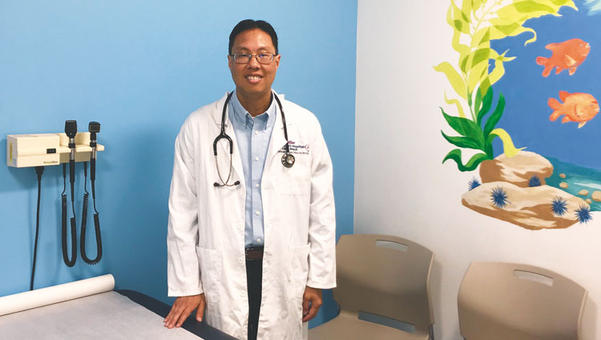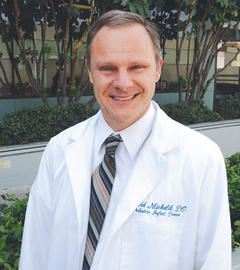In recent years, a number of outbreaks of diseases preventable by vaccination have made headlines. Last year, the measles sickened nearly 50 people in Minnesota, mostly among unvaccinated Somali-American children, according to the Centers for Disease Control and Prevention. In 2014, an outbreak of the measles occurred among visitors to Disneyland, most of whom were unvaccinated. Recently, an infant died in San Bernardino County from whooping cough, a disease that, although preventable by vaccination, resurges cyclically in California.
In 2016, California enacted a law eliminating personal belief vaccination exemptions for children attending private and public schools. The action followed years of a trend in what has become known as “vaccine hesitancy” among families, mostly those well-educated and well off, who question the safety of vaccines. This trend is often traced back to a 1998 study linking autism to the vaccine for measles, mumps and rubella, which was later debunked and retracted.

Dr. Eddie Quan is a partner and general pediatrician at Columbia Pediatrics in Douglas Park. Although vaccination rates have increased in recent years, he noted that ever since a controversial, later discounted study linking autism to the measles vaccine was published in 1998, some parents have opted not to vaccinate their children. (Photograph by the Business Journal’s Samantha Mehlinger)
Now, overall vaccination rates in California are on the rise, according to Dr. Robert Schechter, chief medical officer for the California Department of Public Health (CDPH). “At the kindergarten level in the 2017 to 2018 school year, over 95% of kindergartners were reported to have received the subset of vaccines that were required by state law for school entry,” he told the Business Journal. “That’s roughly about 5% higher over the prior three school years.”
Each autumn, California schools and childcare facilities must report the immunization status of their students to CDPH. “We also follow closely data collected by the federal Centers for Disease Control and Prevention,” Schechter noted. “The data we get for infants in early childhood from CDC shows roughly steady rates for childhood immunization at high levels.”
Schechter believes that legislation in California passed in recent years, including the law eliminating personal belief-related vaccination exemptions for school children, has increased awareness of the importance of immunization among the public. He noted it has also spurred “concerted efforts by local health departments working with schools on meeting those requirements.”
Still, there are certain geographic areas and social groups that have lower rates of vaccination than others in the state, according to Schechter. “Whether you are looking at neighborhoods or social networks or school-based . . . populations, there are pockets of areas with lower immunization rates where diseases can more easily spread if they are introduced,” he said.
Multiple studies have shown that families with higher education and income levels are more likely to question the safety of vaccines, according to Schechter.
Dr. Eddie Quan, partner in Long Beach-based Columbia Pediatrics, has been a general pediatrician for nearly 20 years. In his experience, parents were very accepting of vaccinations when he began practicing medicine in 1999, but after news of the then-recent study linking autism and the measles vaccine spread, more parents became hesitant to immunize their children. “As the dust settled and we found out that the study was retracted and then later on found to be fraudulent, people finally began to realize, OK, maybe we overreacted,” he said.
Now, Quan most often receives questions about vaccines when a new one is released. The vaccine for certain strains of the cancer-causing human papilloma virus (HPV), for example, was approved in 2006. At the time, some parents were hesitant about it, Quan recalled. And because it is still a relatively new vaccine, some still are, he noted.
Quan observed that two groups tend to be more likely to be unvaccinated: those in poorer socioeconomic classes, and those who are wealthier and highly educated. The former are typically unvaccinated because they do not have good access to health care services and thus may not know how to obtain vaccines, Quan explained. Those among the latter group tend to be unvaccinated because they have done reading on the Internet or spoken with others who have influenced their opinion of vaccines negatively, he added.
One of the most common vaccines is for the prevention of influenza, according to Dr. David Michalik, pediatric infectious disease specialist and medical director of MemorialCare Long Beach Medical Center’s Vaccine Hub. Although physicians encourage patients to get the flu shot each year, many still choose not to, he observed.
“We have seen from last year’s flu season, as well as the swine flu season in 2009, that the impact the influenza disease has on the population is significant,” Michalik said. An influenza infection not only causes illness, but in some cases, it can also lead to death, he noted. It is also an expensive infection, he added. Bills from trips to the doctor or the emergency room, or even hospital admission, can quickly add up, he explained. “There still are many unvaccinated individuals despite the fact that influenza can potentially have a devastating impact,” he said.
Many people opt not to get the flu shot because they liken the illness to a simple cold or because they believe it will cause adverse effects, Quan said. It is impossible to become ill from the flu shot because it does not contain a living virus, he pointed out. “What happens is you might have been exposed [to the virus] coincidentally right before you got the vaccine,” he said.
Quan noted that no vaccine is 100% effective, including the flu vaccine. “In fact, this past season, a lot of people did get the flu vaccine but still got the flu,” he said, adding that the shot only covers a few strains of the virus. However, he stressed that those who do receive the flu shot and still get sick typically do not experience complications as adverse as those who do not receive it.

Dr. David Michalik is director of the Vaccine Hub at MemorialCare Long Beach Medical Center and specializes in pediatric infectious disease. At the Vaccine Hub, he offers consultations for individuals preparing to travel to foreign countries to advise them on what vaccinations to receive. (Photograph provided by MemorialCare Long Beach Medical Center)
Michalik explained that, in the history of humankind, there have been two great strides made in reducing infectious diseases. “The first one is good hygiene. And the second is vaccinations,” he said. When the majority of a population receives all the recommended immunizations, not only are they protected, but so are those within the population who cannot be vaccinated, he explained. This concept is called “herd immunity.”
On a small scale, herd immunity works like so: Newborn infants are unable to receive the whooping cough vaccination until they reach two months of age. To protect those infants, a mother, father, and all of the child’s siblings can receive the vaccination in order to greatly reduce the infant’s risk of contracting it, Quan explained.
Michalik noted that it is also important for adults traveling to other countries to research which vaccinations are required to travel, and which are recommended. “There are many that are strongly encouraged for anybody traveling to any other country,” he said, noting that the Vaccine Hub at Long Beach Memorial offers consultations for those planning to travel.
“In an era where we spend so many health care dollars on treating disease, we don’t spend enough money on preventative medicine and really educating individuals to make sure that they are fully aware of the potential for disease and try to minimize the risk,” Michalik said. “This concept of herd immunity, that the majority of people who are vaccinated are also protecting those who are unable to get vaccinated because their immune systems are weak . . . is an incredibly important part of maintaining good health in general.”
Schechter emphasized that, when immunization rates reach a high threshold, the transmission of infectious diseases can be stopped. “The focus on achieving these high levels is to maintain that threshold, that community immunity, and to limit the spread of disease . . . that can easily be introduced by domestic or international travel. And if the disease is getting introduced, then to stop that transmission by having high levels of protection in the community,” he explained. CDPH works closely with local health departments, including the Long Beach Health & Human Services Department, to educate the public about the importance of immunizations, Schechter noted.
For pediatricians at Columbia Pediatrics, disease prevention starts with the birth of their patients. August is immunization month, so the medical group is especially focused on the issue, according to Quan. “When we meet with our patients [and] new moms who are coming in, we ask them, ‘Hey, do you have any concerns?’ And if they bring up any concerns about vaccines, we would definitely want to address it with them, answer any questions they have, provide them with helpful information from our side,” he said.
Quan emphasized, “It’s safe and effective to get all the vaccines according to the schedule that has been laid out. Not only just for the babies, but even for the teenagers.”
